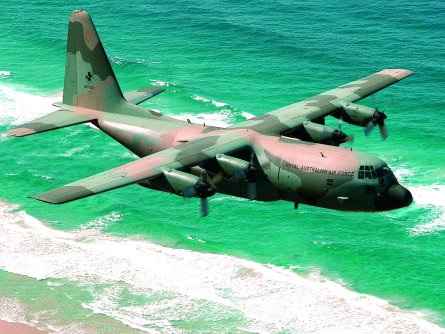Peter La Franchi / London
|
| Australia plans to replace or upgrade the RAAF’s Lockheed C-130Hs |
Australia is to extend its annual 3% increase in defence spending by five years, injecting a further A$10.7 billion ($8.3 billion) into capital funding until 2015. The increase is expected to lead to a significant surge in new acquisition projects from the 2006-7 financial year, which starts on 1 July.
Total Australian defence spending for FY06-7 is forecast at A$22.2 billion, with capital equipment spending expected to total A$4.97 billion. Royal Australian Air Force budget allocations have risen to A$5.1 billion, up A$244 million on mid-year forecasts.
Released last week, the budget plans contain provisional allocations for the proposed purchase of the Lockheed Martin F-35 Joint Strike Fighter (JSF), replacement or upgrade of the RAAF’s Lockheed C-130H transports, and relaunch of Canberra’s long-delayed light tactical airlifter requirement. However, the latter project has been redesignated as a “battlefield airlifter” and will now include consideration of rotary-wing aircraft.
The plans also provide funds to launch a mid-life upgrade to the Royal Australian Navy’s Sikorsky S-70B-2 Seahawk helicopters, and to replace its ageing Eurocopter AS350B trainers.
The RAAF airlift and navy helicopter projects still require additional government review – what the purchasing system calls “first-pass approvals” – over the next 12 months before they can progress to the acquisition phase. The first-pass review for the JSF is due to take place in mid-December.
Projects due to progress to contract signature this year include the acquisition of new electronic support-measure systems and the establishment of a new capability assurance project for the RAAF’s Lockheed AP-3C Orion maritime patrol aircraft. New electronic warfare jammers will also be acquired for its Boeing F-18A/B Hornet fighters – a project that has been delayed since last year.
Australia’s Boeing C-17 airlifter acquisition, now the subject of US foreign military sales negotiations, is expected to cost A$2.2 billion over the first six years. Budget papers reveal the programme will see outlays of A$792 million in FY06-7, A$517 million in FY07-8, A$318 million in FY08-9 and A$121 million in FY09-10. Funding of A$316 million will be provided for the 2010-12 financial years via existing Australian defence capability plan funding. The A$2.2 billion total also includes A$266 million to provide new facilities for the aircraft.
Some A$26 million has been allocated to increase maintenance support for the navy’s Westland Sea King helicopters ahead of their planned replacement.
Source: Flight International
























